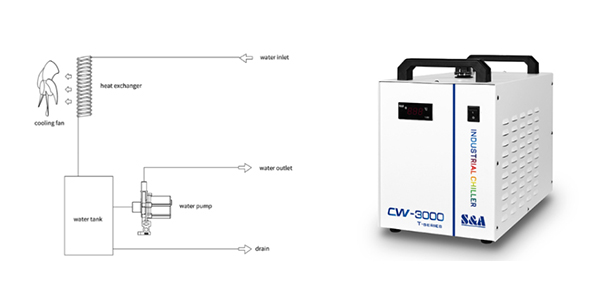The industrial chiller is the supporting refrigeration equipment for spindle equipment, laser cutting and marking equipment, which can provides the function of cooling. We will analyze the working principle according to two types of industrial chillers, the heat-dissipating industrial chiller and the refrigeration industrial chiller.
The working principle of industrial water chiller
The industrial chiller is the supporting refrigeration equipment for spindle equipment, laser cutting and marking equipment, which can provides the function of cooling. Do you know what is the working principle of industrial chillers? Today, we will analyze the working principle according to two types of industrial chillers.
1.The working principle of heat-dissipating industrial chiller
Heat-dissipating chillers, as the name suggests, can only provide heat-dissipating effects. Similar to a fan, it can only provide heat-dissipation and not cooling without a compressor. Because temperature control cannot be achieved, it is mostly used for spindle equipment that does not have strict requirements on water temperature. The heat generated by the main shaft equipment is transmitted to the heat exchanger of the chiller through the circulating water pump, and finally the heat is transferred to the air through the fan, and so on and so forth, continuously providing heat dissipation for the equipment.
the working principle of heat-dissipating industrial chiller
2.The working principle of refrigeration industrial chiller
Refrigeration industrial chillers are mostly used in the refrigeration of various laser equipment because of their adjustable and controllable water temperature. The heat generated by the laser equipment when working passes through the chiller compressor refrigeration system to reduce the water temperature, the low-temperature water is transported to the laser equipment by the water pump, and the high-temperature hot water on the laser equipment is returned to the water tank for cooling and then achieve the effect of cooling the equipment.
the working principle of refrigeration industrial chiller
At present, refrigeration industrial chillers are widely used on the market. The temperature controller can easily control and adjust the water temperature to meet the different needs of various laser equipment for water temperature. There are many choices for temperature control accuracy, ±1°C, ±0.5°C, ±0.3°C, ±0.1°C, high temperature control accuracy indicates that the better the water temperature control is, the smaller the fluctuation is, the more conducive to the light output rate of the laser.
The above is a summary of the working principles of the two types of chillers. When choosing a chiller, it is necessary to confirm which type of chiller is suitable for configuration.

We're here for you when you need us.
Please complete the form to contact us, and we'll be happy to help you.











































































































